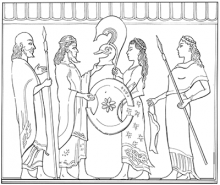
You are here
Episode 8: New Armour for Achilles
Story summary
Teaching activities
- Starting points
- Follow-up
- Further activities
Remind the children of the scene with Hector and Andromache and of Andromache’s reason for fearing Achilles. (He had killed her family.)
-
What was the name of Hector’s son? (Astyanax.) What had he been afraid of? (Hector’s feathered helmet.) When Hector lifted Astyanax up to Zeus, what did he say? (“May this child grow up to be greater than his father.”) How did Zeus respond? (He did not bow his head in assent.) What might this mean?
-
Who gives Patroclus courage? (Hera.) What does he do? (He puts on Achilles’ armour and joins the fighting.)
-
What does Patroclus give to Achilles before he leaves? (The ring that Achilles had been given by Thetis.) Why does he do this?
- Which similes are used to describe the Myrmidons and Patroclus? (Myrmidons like angry wasps; Patroclus like a hawk.) Can the class find other examples of how actions and people are compared to animals? Give eight groups an episode each and ask each group to make a list of similes used. As an extension exercise the class can work in groups to make up some of their own similes and metaphors
-
What are the two ways that Achilles hears of Patroclus’ death? (A thousand voices; the ring bleeds.)
-
When Odysseus goes to Achilles what does he see? The class can read p 2 of the
![[pdf] [pdf]](/sites/default/files/pdf_icon.png) transcript. Why does Odysseus run away from Achilles? (He is filled with pity for him.)
transcript. Why does Odysseus run away from Achilles? (He is filled with pity for him.) -
Dramatise the scene where Odysseus returns to camp and tells the other warriors about Achilles, and how he has reacted to the death of his friend.
-
Ask children to write a poem about Achilles’ grief.
-
Write a modern obituary describing the qualities and attributes of Patroclus.
-
Can children imagine how Achilles feels as he puts on this new armour? Describe these thoughts and feelings. Alternatively, write a letter or a diary entry from Achilles to Patroclus.
-
Hector is described by Thetis as “man-slaying.” For what reasons could Achilles, her son, be described in this way too?
-
If the class has been making a cartoon strip, picture or model of the war, where would they put Patroclus and Hector now? Ask them to describe the progress of this battle. (Three times Patroclus has climbed the walls of Troy. Three times he has been driven down with spears.)
-
Describe the shield that Hephaestus, at the request of Thetis, has made for Achilles. (See
![[pdf] [pdf]](/sites/default/files/pdf_icon.png) transcript p. 3.) Using this description, can children sketch, paint or make a representation of the shield? Compare it with the shield on the illustration,
transcript p. 3.) Using this description, can children sketch, paint or make a representation of the shield? Compare it with the shield on the illustration, ![[pdf] [pdf]](/sites/default/files/pdf_icon.png) Achilles’ new armour: why is the shield in the illustration so different from that described in the story?
Achilles’ new armour: why is the shield in the illustration so different from that described in the story? -
Why do children think Thetis is so determined to help her son, Achilles? (She is still desperate to thwart the prophecy that Achilles would be greater than his father, but die young.) Ask the class if they remember what this prophecy is and what Thetis did early in the story to protect her son. (Thetis had dipped Achilles in the river Styx to protect him and later disguised him as a young woman.)
-
What will Achilles’ new armour not do for him? (It will not protect him from his fate.)
How could Achilles commemorate Patroclus? What would the children do if they were him? When people die now, what do we do to remember and/or celebrate their lives?
Visual aids
Achilles' new armour
Based on a black figure vase, sixth century BC. British Museum, London.
With the death of Patroclus Achilles loses his armour. Before he can go out to fight Hector, he has to have new armour made by Hephaestus, the god of metalworking. Here Zeus presents Achilles’ new armour to Thetis, who had persuaded Hephaestus to undertake the task. Behind Thetis one of her sisters holds a spear and greaves. For obvious reasons the artist has not tried to show on the shield the very detailed scenes described in the second part of Episode 8 (closely based on Homer’s description in the Iliad).
